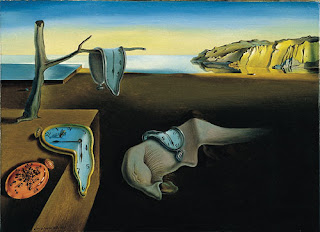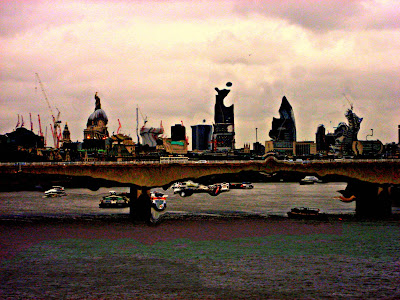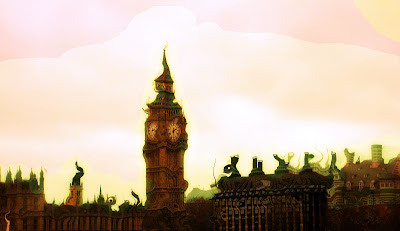
I used two of his paintings (The painting on the right is titled "Soft Watch at the Moment of First Explosion", C. 1954. The second painting below is titled "The Persistence of Memory", C. 1931). I studied some of the motifs and ideas Dali used, and tried to incorporate them into my photo manipulations, to demonstrate that photography can be used to convey reality, as well as art.

The first photograph I chose to manipulate can be seen on the right. I took it when I lived in London, England in 2007.
 It is a snapshot of the heart of the city from afar. I took it while standing on a bridge. I feel that it accurately portrays a typical day in London. Dark, dull, mostly overcast background, with history and architecture in between. For the most part I believe that this is a fairly boring photograph, and is almost the complete opposite of any work of art that Salvador Dali has ever painted.
It is a snapshot of the heart of the city from afar. I took it while standing on a bridge. I feel that it accurately portrays a typical day in London. Dark, dull, mostly overcast background, with history and architecture in between. For the most part I believe that this is a fairly boring photograph, and is almost the complete opposite of any work of art that Salvador Dali has ever painted.The photo manipulation process began with a free online program called Picnik. This assignment marks the first time I have ever manipulated a photograph as well, as using digital editing programs. I began by fixing the quality of my original photo. I removed most of the grey caused by overcast. By playing with the colour saturation and temperature I was able to achieve a nice blend of colours, which I thought represented Dali's use of vibrant backgrounds. I used multiple shades of purple for the sky, including the clouds. I highlighted this by using similar colours at the base where the water shows. My second step was using a tool called 'gooify', this tool helped me create the illusion as if main focal points were melting. Instead of making every aspect of the photo appear to be melting I highlighted major focal points, this gives the eye a central area of focus. Thirdly, I used the painting tool to add accent colours like the gold you see on the bridge, and some green you see on the buildings to allow for contrast. For the last step I modified the photograph with the focal pixalate tool. By increasing the strength I thought that the photograph began to look more like a painting. The effect created what looks like hundreds of tiny brush strokes. This helps my manipulation look more like a painting then a photograph. The end result can be seen below.

The second photograph I took is also from London, but the main focus is of Big Ben. I used this image, because Dali often used images of melting clocks in his work.
 The first modification in Picnik I used was the exposure tool. I adjusted the contrast and the exposure amount in make the picture look more clear. Secondly, I used the focal zoom tool to enhance, and bring out Big Ben. I wanted Big Ben to be the prominent image. In combination with the exposure tool, I cropped the photograph, which ended up eliminating the amount of excess sky, and I was happy with the end results. By cropping the photograph the other images appear larger. The second modification I made was again with the 'gooify' tool. I have to admit by the second time using it, it became easier for me, and I learned how to maximize it's potential. Again I avoided 'gooifying' the entire image. I focused on only the main images in the foreground. I am happy with the way Big Ben looks. Thirdly, I began playing with some of the editing tools. I adjusted all the colours, since neutral shades and brown dominate the original photograph. I played with the sky, and tried to change the atmosphere from dark, dull and grey, to a more positive mood. It added colour shading, and highlights to make it look as though the sun was shinning. I found the paint brush tool very time consuming, but also very effective. The paint brush tool made me feel as though I was an artist, with a blank canvas to be creative with. I also used the paint tool to add some green to the buildings. I used the focal soften tool to blur the background slightly. This allowed the foreground to be more present to the eye, and take away unwanted focus on secondary images. This tool was very easy to use. Lastly, I used some of the advanced editing tools to again make the photograph look more like a painting. I found the focal pixalate tool the best for this outcome. The finished result can be seen below.
The first modification in Picnik I used was the exposure tool. I adjusted the contrast and the exposure amount in make the picture look more clear. Secondly, I used the focal zoom tool to enhance, and bring out Big Ben. I wanted Big Ben to be the prominent image. In combination with the exposure tool, I cropped the photograph, which ended up eliminating the amount of excess sky, and I was happy with the end results. By cropping the photograph the other images appear larger. The second modification I made was again with the 'gooify' tool. I have to admit by the second time using it, it became easier for me, and I learned how to maximize it's potential. Again I avoided 'gooifying' the entire image. I focused on only the main images in the foreground. I am happy with the way Big Ben looks. Thirdly, I began playing with some of the editing tools. I adjusted all the colours, since neutral shades and brown dominate the original photograph. I played with the sky, and tried to change the atmosphere from dark, dull and grey, to a more positive mood. It added colour shading, and highlights to make it look as though the sun was shinning. I found the paint brush tool very time consuming, but also very effective. The paint brush tool made me feel as though I was an artist, with a blank canvas to be creative with. I also used the paint tool to add some green to the buildings. I used the focal soften tool to blur the background slightly. This allowed the foreground to be more present to the eye, and take away unwanted focus on secondary images. This tool was very easy to use. Lastly, I used some of the advanced editing tools to again make the photograph look more like a painting. I found the focal pixalate tool the best for this outcome. The finished result can be seen below.
To conclude, my main focus was to present a photograph as a more traditional format of art. Although, I believe that photography is art in itself, some people don't have the same beliefs, and feel this particular way. I have always embraced the photo medium. The end results I feel not only portray my photographs as surrealist paintings, but also transformed two very bland photographs into two more interesting pieces of art.
